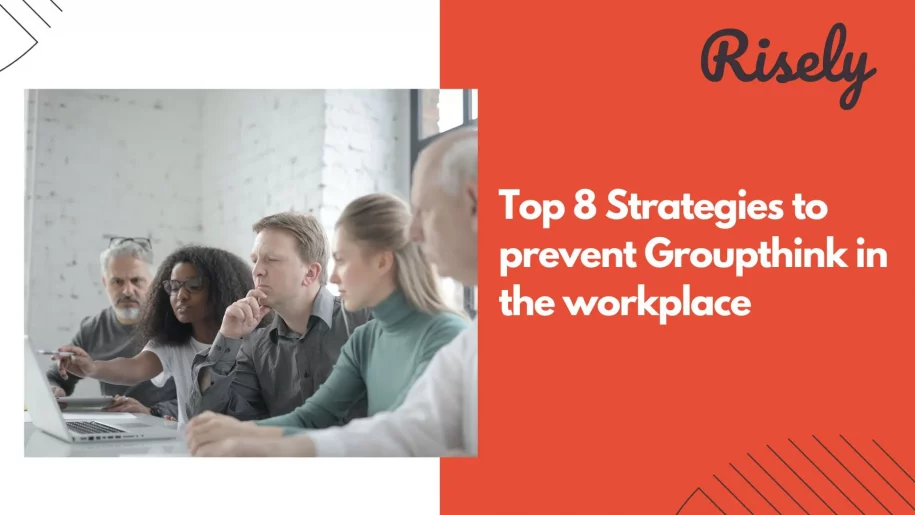Top 8 Strategies to prevent Groupthink in the workplace
Groupthink is a silent menace that can creep into the workplace, undermining the very essence of effective decision-making and innovation. Organizations may unknowingly stifle diverse perspectives, creativity, and critical evaluation in pursuing consensus and harmony. Understanding groupthink and how it manifests is essential for leaders and teams seeking to create a more open, inclusive, and productive work environment. In this blog, we’ll explore the concept of groupthink, its signs, causes, and, most importantly, strategies to prevent and overcome it in your workplace.What is groupthink in the workplace?
Groupthink in the workplace refers to a psychological phenomenon that occurs when a group of individuals within an organization makes decisions or reaches a consensus that discourages dissenting viewpoints or critical thinking. In such situations, group members prioritize harmony and conformity over the quality of the decision-making process. This can lead to flawed or suboptimal decisions because alternative perspectives and potential drawbacks are not adequately considered. Groupthink can harm organizations, including poor decision-making, missed opportunities, and a lack of innovation. Organizations can encourage a culture of open communication, diversity of thought, and constructive dissent to prevent or mitigate groupthink in the workplace.Examples of groupthink in the workplace
Groupthink in the workplace can manifest in various ways, often leading to suboptimal decisions. Some examples of groupthink scenarios that can occur in professional settings:- Project approval without due diligence: A project proposal is presented in a corporate board meeting. The team members, eager to please the leadership and avoid conflict, unanimously approve the project without thoroughly examining the potential risks, costs, or feasibility. As a result, the project encounters unexpected obstacles and budget overruns.
- Hiring based on likability: During a job interview panel, the interviewers quickly reach a consensus on hiring a candidate because they all liked the person’s personality. No one raises concerns about the candidate’s lack of specific skills or qualifications relevant to the job—the new hire struggles to perform their tasks effectively.
- Ignoring early warning signs: In a financial institution, managers dismiss early signs of a potential economic downturn because they believe the company is too successful to be affected. They ignore the concerns raised by analysts and continue with high-risk investments, which result in significant financial losses.
- Suppressed creative input: A creative brainstorming session is dominated by a few assertive team members who quickly dismiss alternative ideas. Other team members, fearing criticism, hold back their creative input, leading to missed opportunities for innovative solutions.
What causes groupthink in the workplace?
A combination of factors and dynamics within a group or organization can cause groupthink in the workplace. These factors can create an environment where individuals are inclined to conform to the consensus rather than critically evaluate decisions. Some common causes of groupthink in the workplace:- Strong desire for cohesion: When a team or group places a high value on maintaining harmony and avoiding conflict, members may hesitate to express dissenting opinions that could disrupt unity. This desire for cohesion can lead to suppressing critical thinking.
- Lack of diverse perspectives: Homogeneous teams, where members share similar backgrounds, experiences, or perspectives, are more susceptible to groupthink. Without diverse viewpoints, there is a reduced likelihood of challenging the status quo.
- Authoritarian leadership: Leadership styles that discourage dissent and emphasize a top-down decision-making approach can foster groupthink. Employees may be less likely to express their opinions or concerns in such environments.
- Time pressure: Teams or groups operating under tight deadlines or facing time constraints may prioritize making quick decisions over thorough deliberation. This rush can lead to skipping critical evaluation steps and a tendency to conform to the quickest solution.
- Fear of reprisal: Employees who fear negative consequences, such as retribution or damage to their careers, for expressing dissent may choose to remain silent rather than voicing their concerns.
- Stereotyping dissenters: Group members may stereotype those who express dissenting opinions as troublemakers, negative, or uncooperative. Such stereotypes can discourage individuals from challenging the consensus.
Other Interesting Reads
Effects of groupthink in the workplace
Groupthink in the workplace can have several detrimental effects on decision-making processes and organizational outcomes. These effects can hinder innovation and contribute to a less productive and creative work environment. Some common effects of groupthink in the workplace:- Poor decision-making: One of the most significant effects of groupthink is the generation of bad decisions. When dissenting opinions are suppressed, alternative viewpoints are not considered, and critical evaluation is lacking, decisions may overlook potential risks, drawbacks, or better alternatives.
- Reduced innovation: Groupthink stifles creativity and innovative thinking. When conformity is prioritized over diversity of thought, employees are less likely to propose new ideas or challenge the status quo, limiting the organization’s ability to adapt and innovate.
- Missed opportunities: Groupthink often leads to a narrow focus on a single course of action, disregarding other potentially valuable options. This can result in missed opportunities for growth, expansion, or market advantage.
- Increased risk: Flawed decisions made under the influence of groupthink can expose the organization to greater risks, including financial losses, reputation damage, and legal liabilities.
- Lower quality of work: When decisions are made without thorough evaluation, the quality of work may suffer. Products, services, or projects that result from groupthink-driven decisions may lack the necessary quality or effectiveness.
8 Strategies to avoid Groupthink in the workplace
Avoiding groupthink in the workplace is crucial for encouraging diverse perspectives. Some strategies that organizations and teams can take to prevent groupthink:- Appoint a devil’s advocate: Designate a team member to play the role of a devil’s advocate during discussions. This individual’s role is to challenge prevailing opinions and assumptions, stimulating critical thinking.
- Encourage constructive dissent: Reward and recognize employees who provide constructive dissent and alternative perspectives. Make it clear that dissenting opinions are valued and appreciated for their potential to improve decision-making.
- Diversify teams: Form teams with diverse backgrounds, experiences, and perspectives. A mix of individuals with different viewpoints can help counteract groupthink by bringing fresh ideas.
- Use structured decision-making processes: Implement structured decision-making frameworks that require thoroughly evaluating options, including considering potential risks and drawbacks.
- Rotate leadership roles: Rotate leadership or facilitation roles within teams to avoid a single individual or group dominating decision-making. Different leaders may bring different leadership styles and viewpoints to the table.
- Encourage healthy conflict: Foster an environment where healthy conflict is seen as a means to arrive at better solutions. Encourage team members to challenge each other’s ideas respectfully and constructively.
- Implement anonymity: In some cases, anonymity can encourage employees to express their concerns or dissenting opinions more freely. Consider anonymous suggestion boxes or feedback mechanisms.
- Encourage reflection: Encourage team members to reflect on decisions made and the decision-making process. This reflection can help identify areas for improvement.
Conclusion
Groupthink is a formidable adversary to sound decision-making and innovation in the workplace, but it’s not insurmountable. As we conclude our exploration of this phenomenon, it’s clear that awareness and proactive measures can combat the negative effects of groupthink. Remember that a culture of open communication, where diverse perspectives are valued, and dissent is encouraged, can be your greatest ally in preventing groupthink. Incorporating the strategies mentioned above into your organization’s DNA will pave the way for more informed choices, greater creativity, and a more inclusive and innovative workplace.Ready to Break Free from Groupthink?
Assess your Decision-making skills for free and lead your team to better choices! Take the assessment now.
Other Related Blogs
5 Unique Benefits Of Online Leadership Coaching
5 Unique Benefits Of Online Leadership Coaching Remember the days of leadership development being confined to a stuffy conference room filled with flipcharts and generic advice? Yeah, those days are…
Performance Management Training: Empowering Managers To Manage Better
Performance Management Training: Empowering Managers To Manage Better Remember that feeling of dread when you knew performance review season was rolling around? Yeah, us, too. For many employees, performance reviews…
Manager Development Goals And How To Reach Them: Opportunities And Areas To Focus On
Manager Development Goals And How To Reach Them: Opportunities And Areas To Focus On You’ve meticulously crafted a development program for your high-potential employees, but their managers just aren’t on…
Grooming for Management: The Key to Building a Sustainable Leadership Pipeline
Grooming for Management: The Key to Building a Sustainable Leadership Pipeline Imagine a crucial leadership position opening up in your organization. You scramble to fill the role, internally and externally,…


